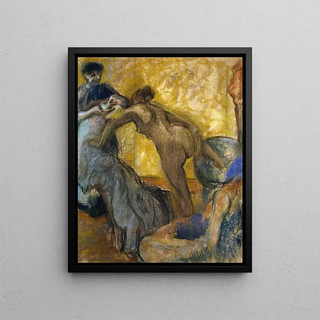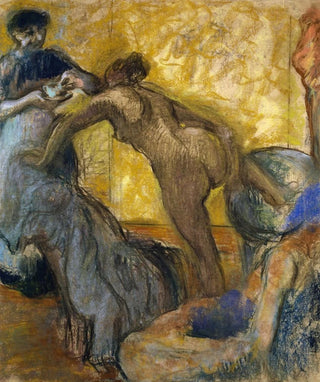Art print | The cup of hot chocolate - Edgar Degas


View from behind

Frame (optional)
In the fascinating world of Impressionist art, the artwork "The Hot Chocolate Cup" by Edgar Degas stands out for its intimate atmosphere and its ability to capture moments of everyday life. This painting, where the sweetness of a hot chocolate cup blends with the delicacy of gestures, invites the viewer to immerse themselves in a suspended moment, a moment where time seems to stand still. The subtle light playing on surfaces, delicate shadows, and harmonious composition create a warm and welcoming ambiance, evoking the simplicity of life's pleasures. This masterpiece, both accessible and poetic, embodies the very essence of Degas's art, who knew so well how to immortalize fleeting moments of existence.
Style and uniqueness of the work
Degas's style, characterized by meticulous attention to detail and exceptional mastery of light, is fully expressed in "The Hot Chocolate Cup." The artist uses delicate nuances and warm colors to evoke a welcoming atmosphere, where hot chocolate becomes much more than a simple drink: it becomes a symbol of comfort and conviviality. The composition of the painting, with its gentle lines and rounded shapes, guides the viewer's gaze toward the center of the work, where the cup majestically sits. Degas, a true visual poet, manages to transform a mundane moment into a scene charged with emotion, inviting everyone to feel the warmth of this shared moment. The absence of human figures only accentuates the intimate character of the work, leaving room for the viewer's imagination to freely project themselves.
The artist and his influence
Edgar Degas, an emblematic figure of Impressionism, established himself as one of the masters of modern painting. Born in Paris in 1834, he explored various themes throughout his career, ranging from ballerinas to café scenes, including portraits and landscapes. His innovative approach, blending realism and Impressionism, profoundly influenced many artists. Degas does not merely reproduce reality; he seeks to capture its essence.

Matte finish

View from behind

Frame (optional)
In the fascinating world of Impressionist art, the artwork "The Hot Chocolate Cup" by Edgar Degas stands out for its intimate atmosphere and its ability to capture moments of everyday life. This painting, where the sweetness of a hot chocolate cup blends with the delicacy of gestures, invites the viewer to immerse themselves in a suspended moment, a moment where time seems to stand still. The subtle light playing on surfaces, delicate shadows, and harmonious composition create a warm and welcoming ambiance, evoking the simplicity of life's pleasures. This masterpiece, both accessible and poetic, embodies the very essence of Degas's art, who knew so well how to immortalize fleeting moments of existence.
Style and uniqueness of the work
Degas's style, characterized by meticulous attention to detail and exceptional mastery of light, is fully expressed in "The Hot Chocolate Cup." The artist uses delicate nuances and warm colors to evoke a welcoming atmosphere, where hot chocolate becomes much more than a simple drink: it becomes a symbol of comfort and conviviality. The composition of the painting, with its gentle lines and rounded shapes, guides the viewer's gaze toward the center of the work, where the cup majestically sits. Degas, a true visual poet, manages to transform a mundane moment into a scene charged with emotion, inviting everyone to feel the warmth of this shared moment. The absence of human figures only accentuates the intimate character of the work, leaving room for the viewer's imagination to freely project themselves.
The artist and his influence
Edgar Degas, an emblematic figure of Impressionism, established himself as one of the masters of modern painting. Born in Paris in 1834, he explored various themes throughout his career, ranging from ballerinas to café scenes, including portraits and landscapes. His innovative approach, blending realism and Impressionism, profoundly influenced many artists. Degas does not merely reproduce reality; he seeks to capture its essence.






